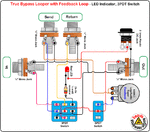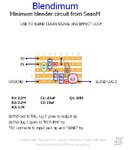ragingben
Newbie level 5
- Joined
- Oct 6, 2011
- Messages
- 9
- Helped
- 0
- Reputation
- 0
- Reaction score
- 0
- Trophy points
- 1,281
- Location
- Somerset, England
- Activity points
- 1,364
Hi everyone, I have what I hope is a really easy question.
I am creating a blendable feedback loop circuit, which has 4 jack sockets (guitar in, send, return and out), and a pot between the return and send jacks so I can send the signal back to the send, creating a loop. This all works well. I also have a blend circuit, so that the dry input signal can be blended with the loop.
The problem is, as the signal goes from the return -> pot -> send, and the dry signal goes to send, some of the feedback signal is bleeding back down into the dry signal, and makes blending ineffective.
So what I am asking is this: how do I stop the signal bleeding. I was thinking I need to use a diode, I tried a 1N4001, and it didn't work at all, just made the signal horrible. I tried a zener diode I had lying around, and it had no audible effect, but didn't seem to stop the signal bleeding.
I have attached a very crude picture to help explain what I mean, where the ? is I think I need some kind of diode to only let the signal pass one way.
Any help is very greatly appreciated!

I am creating a blendable feedback loop circuit, which has 4 jack sockets (guitar in, send, return and out), and a pot between the return and send jacks so I can send the signal back to the send, creating a loop. This all works well. I also have a blend circuit, so that the dry input signal can be blended with the loop.
The problem is, as the signal goes from the return -> pot -> send, and the dry signal goes to send, some of the feedback signal is bleeding back down into the dry signal, and makes blending ineffective.
So what I am asking is this: how do I stop the signal bleeding. I was thinking I need to use a diode, I tried a 1N4001, and it didn't work at all, just made the signal horrible. I tried a zener diode I had lying around, and it had no audible effect, but didn't seem to stop the signal bleeding.
I have attached a very crude picture to help explain what I mean, where the ? is I think I need some kind of diode to only let the signal pass one way.
Any help is very greatly appreciated!


